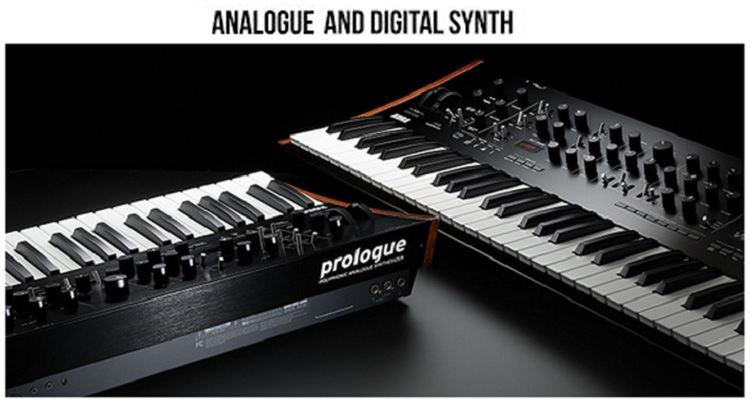
Analog vs. Digital Synthesizers: Understand the basics of these popular types of synthesizers.
For someone who has grown p playing electronic keyboards and digital pianos, synthesizers and midi controllers may seem like an alien instrument, despite the familiar looks.
For many, a synthesizer comes across as a complex instrument, and to further add to the mystery, there are analog as well as digital synthesizers.
Here, we take a look at the differences between Analog and Digital Synthesizers.
What Is An Analog Synthesizer?
An analog synthesizer produces sounds by sending waveforms (of different shapes) through the circuit board. The different shapes, such as saw, square, triangle, and sine, produce sounds with different timbre.
For instance, a saw wave is very buzzy sounding (because the wave is pointy and sharp) whereas a sine wave is much smoother (because the sine wave is smooth).
These are only the raw waveforms.
You can further manipulate/filter these waveforms using various ways, such as adjusting the cutoff and resonance filters, adjusting the length of the notes through the attack, decay, release, and sustain envelopes.
When it comes to synthesizers, you have to deal with filters and envelopes, in order to add variations to the sounds. There are more sound-changing parameters, but these are the primary ones.
Analog Synthesizers Vs Digital Synthesizers
- Analog synths use real circuits to create these sounds, digital synths uses samples to emulate analog synths.
- Synth purists/expert musicians feel digital synths don’t fully match the customizing options of analog synths, and they don’t sound as fat as analog synths (though that’s subjective).
- Analog synths can feel like a different beast when you use it for the first time – all those knobs, thick, warm (vintage) sound. It comes across as a real piece of hardware.
- Digital synths are much easier and ready to go, to use thanks to the various presets.
Most musicians prefer analog synths for its customizing options; there’s already a knob for most purposes and you
have to use those knobs. On a digital synth, you will need to scroll through various menus to do the same. For example, you may have to assign the pitch envelope function to a knob, before being able to use it.
Digital synths however have a cleaner user interface, with fewer knobs (looks less intimidating to someone who is graduating from an arranger keyboard or a digital piano). You can also assign effects to assignable knobs, which you can’t do on an analog synth.
That’s it, so go ahead and make your pick.
Watch: Analog vs Digital Synthesizers
To Summarize
- Raw waveforms, Produces warmer & thicker sounds
- Gives you lot of options to customize the sounds
- Lots of Physical knobs makes it easier to tweak sounds on the go
- Lots of Presets (some are very powerful)
- Digital emulation allows smoother/easier manipulation
- Fewer knobs (sometimes)
- More Assignability options
What to Buy
Its not that one is better compared to the other. There are some amazing analog synths and also some bad analog synths, and the same applies to digital synths as well.
If you want more control over the raw waveforms, more hands-on customization, go for analog synths.
If you prefer presets, assignable knobs, simple features, go for a digital synth.
You can read more about the basics of synthesizers here.
Checkout some of my favorite synthesizers, mix of digital as well as analog, and how they match up with my top rated synthesizers.
Korg MicroKorg
37 Keys, digital synthesizer (not an analog one). Sounds great, easy to use, great beginner synthesizer.
Roland System 1
It feels like an analog synth with all those knobs (but it actually simulates an analog circuit)
Sequential Prophet 6 (by Dave Smith)
49-key polyphonic analog synthesizer with velocity, after-touch, 6 oscillators, plus all of your standard filters and envelopes, and a pitch and modulation wheel. One of the greatest analog synthesizers of all time.
Nord Lead 4
49 polyphonic keys. Nord simulates analog sounds very well, has several features as the Prophet 6, but its still a digital synth (and costs less). But experts will still prefer the Prophet.
Moog Sub 37 Tribute Edition
Moog are well-known for their analog synths that produce the fattest analog sound on the market. The Moog Sub 37 Tribute Edition (37 key) is no different.
Suresh has a background in computer science, in addition to being a keyboard/piano player. He has a keen interest in music, audio & video gear, and also manages the business part of KeytarHQ. Read more here.



Leave a Reply